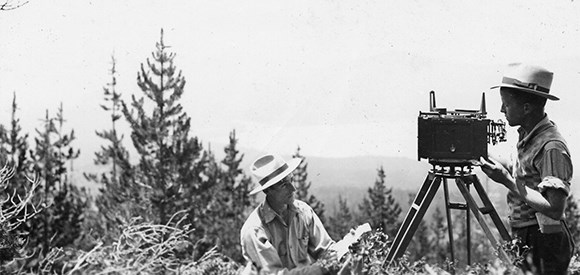Last updated: August 12, 2025
Article
History of the Panoramic Lookout Project

Crater Lake as seen from The Watchman Lookout. was originally photographed by Lester Moe and Robert Snyder in 1933 as part of the US Forest Service project and rephotographed in 1935 for the National Park Service project.
The Forest Service project focused on Oregon and Washington, as well as a small portion of Idaho. Because the project focused on all federal and state lookout points, it included some locations that are National Park Service sites, such as Crater Lake, Mount Rainier, Olympic, and North Cascades National Parks and Lake Chelan National Recreation Area (NRA). Note: At the time the images were taken, Lake Chelan NRA was within a US Forest Service unit. The National Park Service project expanded well beyond the Pacific Northwest to 200 lookout locations across the entire United States.
Several innovations came about as a result of the Forest Service project. These included not only the camera used to take the photographs—the Osborne photo-recording transit—but also working with Eastman Kodak Company as they developed a film that would not be affected by the smoke and haze so prevalent in the Cascades during the summer months. They used “special emulsion infra-red sensitive film that when used with red filters cut through haze and smoke miraculously.”
Material for this section credited to History of the Rogue River National Forest: Volume 2 – 1933-1969.
Who Was Lester Moe?

Image courtesy of Moe family.
Born on January 21, 1910, in Portland, Oregon, Lester Maynard Moe joined the Civilian Conservation Corps (CCC) at age 23 as an enrollee recruited for the panoramic photograph project that began on June 11, 1933. He worked for the US Forest Service taking photographs in 1933 and 1934. In 1934, “Mr. Moe had terminated his services to resume college…” (Arnst, 1985, p. 12) and apparently joined the National Park Service as a junior forester that same year. At the completion of the National Park Service project, it was noted that he worked on it from 1934 to 1938.
The June 1938 Park Service Bulletin highlighted the completion of the project:
Chief Forester Coffman announces completion of a 4-year project for obtaining panoramic photographs from the 200 existing and proposed forest fire lookouts throughout the entire Federal Park System.
The photographic work, done by Junior Forester Moe, entailed many hardships not only in packing the necessary equipment weighing upwards of 100 pounds to lookout points, but also in climbing trees, poles, temporary towers, or roofs of lookouts with the equipment and facing the extreme winds that occur so frequently at high elevations.
—Park Service Bulletin, June 1938, pg. 6
The next notation regarding Mr. Moe is as a ranger in Yosemite National Park from June 1940 to November 1942, when he went into the Navy Air Service. After the war, he returned to Yosemite as a ranger and in 1946 joined the park’s engineer department. He worked the 1949 summer season in Mount Rainier National Park, but by November of that year was back in the Engineer Department of Yosemite. (Bingaman, 1961). According to the California Death Index, Lester Moe died in Merced, California, on August 27, 1990.
Material for this section credited to Albert Arnst's article We Climbed the Highest Mountains and John W. Bingaman's work Guardians of the Yosemite.

About the Osborne Camera
The camera Lester Moe used, known as an Osborne photo-recording transit, was designed by W. B. Osborne, a U.S. Forest Service employee, for fire protection purposes. Custom made, it combined the features of an engineering surveyor’s transit with photographic capabilities. Additionally, Mr. Osborne designed the Osborne fire finder to help pinpoint forest fire locations. Osborne fire finders are still in use in many lookouts today.
Each camera weighed approximately 75 pounds, and was often carried on the photographer’s back up to the lookout. The film was stationary while the lens rotated 120° from right to left for each frame, providing a fixed focal length across the width of the film.

The sun’s position dictated when each photograph could be taken, with the 180°-300° arc photo taken about 9:00 a.m., the 300°-60° arc photo about 12:00 p.m., and the 60°-180° arc photo about 3:00 p.m. The camera was positioned along the catwalk of the lookout when possible, but it was sometimes necessary to climb towers, roofs, and trees to take photographs.
Material for this section credited to USGS Northern Rocky Mountain Science Center.
Infrared versus Panchromatic Film

Lester Moe
Two types of Eastman Kodak film were used: 1. panchromatic film, which is sensitive to light of all colors in the visible spectrum, and 2. infrared film, which is sensitive to electromagnetic wavelengths longer than the visible spectrum, 0.7 mm to ~3 mm. Filters used with panchromatic film included a K2 (Wratten No. 8) and #12 deep amber (minus blue member of the cyan-magenta-yellow set of subtractive primaries), while filters used with infrared film included A-red (Wratten No. 25) and F-red (Wratten No. 29). The negatives and contact prints are of very high quality film and photography. However, the negatives, which measure approximately 5 ½ inches x 13 ½ inches, are nitrate-based and require careful handling and storage.
The crew used infrared film primarily in an effort to cut through any haze that was in the atmosphere. This produced a higher contrast image of the “background,” which was the primary focus of the images taken.
Compare the images above and below to see the differences between infrared and panchromatic film. In the black and white 1930’s images above, the differences are most visible in the vegetation and the sky. In the 2008 images below, the differences between infrared and panchromatic are very obvious, as healthy trees appear red in infrared images, and green in panchromatic images.

Ian Grob
